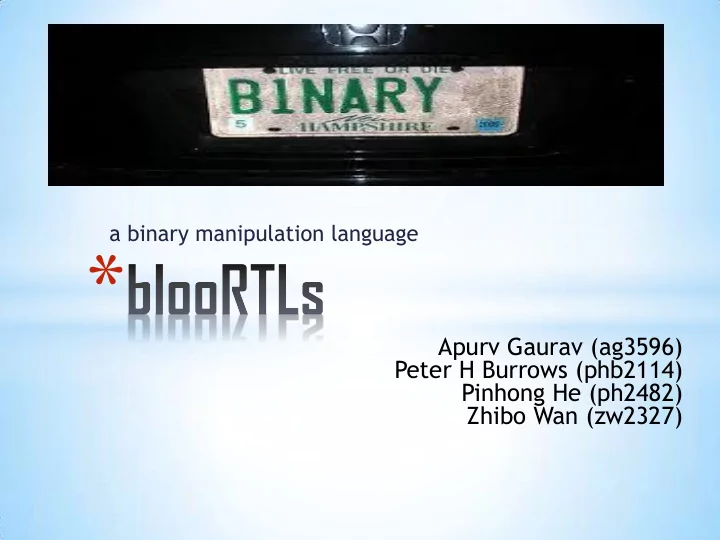

a binary manipulation language * Apurv Gaurav (ag3596) Peter H Burrows (phb2114) Pinhong He (ph2482) Zhibo Wan (zw2327)
Motivation, Overview, and Tutorials Introduction of the blooRTLs • Language Features Project Architecture and keywords • Scanner, Parser, AST , VHDL Test Suites Summary and Lessons Learned Demo! *
- An RTL description language geared towards catalyzing the development, simulation, and synthesis of RTL specs - “Object - Oriented” - but NOT in the traditional sense - “Reasonably” fast clock frequency assumed (>MHz) - Compiles down to Sequential VHDL * Overview: Behavioral Language for Object-Oriented RTL Specs
blooRTLs Tutorial “Objects” of variable “var” middle2 ms lsb bits b 1 0 0 0 0 0 0 1 1 0 0 0 1 0 0 1
Compiler Considerations for VHDL: The VHDL Libraries NOT STANDARDIZED IEEE STANDARDIZED - Early 1990s → Synopsys developed the arithmetic library with a user-friendly VHDL arithmetic syntax and packaged it into the IEEE library - Late 1990s → IEEE developed and standardized the numeric library due to unexpected behavior across various toolkits that used the arithmetic library
Compiler Considerations for VHDL: The VHDL Libraries NOT STANDARDIZED - Tradeoff: The NUMERIC library is MORE RELIABLE for simulation and synthesis, however it is much QUIRKIER ! - It does NOT raise an error for overflow/underflow - It does NOT permit arithmetic for vectors of varying lengths; however, there is a clever work-around
Compiler Considerations for VHDL: The Sequential Framework The Main Logic: 7
blooRTLs Compiled 2 clock cycles The Bottom Line : the blooRTLs compiler performs Concat operator VHDL “length inferencing” for you 8
Precompiler - Before compiling, the blooRTLs source code MUST be precompiled in order to: - Cache the bit vector indices given by the BINMAP - Check for arithmetic over/underflows - In Ocaml , a map module was implemented to cache/log the values and indices of variables and objects...
Precompiler: Ocaml environment It’s a Map of Maps! Keys (Variables) Values (Maps) Keys (Objects) Values (Tuples of int*int list * int list)) ( 137, [7;6;5;4;3;2;1;0], [1;0;0;0;1;0;0;1],0 ) “” → “var” → “ msb ” → ( 1, [7], [1], 0 ) “ lsb ” → ( 1, [0], [1], 0 ) ( 1, [4;3], [0;1], 0 ) “middle2bits” → 10
blooRTLs source code Pre Scanner Parser/AST compiler VHDL Compiler *
* Variable Declaration var1 * Assign value for variables := * Basic operations: + - * = * Binary shifting << >> * BINMAP * IF-THEN-ELSE, REPEAT-UNTIL * PRINT *
*
*
*
* * Using blooRTLs bit-mapping feature on sequential data, we can encode important sequential data, such as DNA, and be able to track genes * In addition, DNA encoding can be optimized to use less space and digits * Original Encoding: * A = 00, C = 01, T = 10, G = 11 * Huffman Encoding: * A = 0, T = 10, C = 101, G = 110
* * We will take a DNA sequence BINMAP var1 { nucleotide := [1][0]; that has been encoded into } binary numbers and count var1 := how many of each 1000110000000010001001101111010111001101001010000001110110001011000000; nucleotide there are. adenosine := 0d; cytosine := 0d; thymine := 0d; guanine := 0d; * Features Tested: REPEAT ( * BINMAP IF (var1.nucleotide = 00) , If-Then-Else, Repeat-Until, PRINT , bit THEN ( adenosine := adenosine + 1d; manipulation, (Switch) var1 >> 2d; ) IF (var1.nucleotide = 01) THEN ( cytosine := cytosine + 1d; Output: var1 >> 2d;) 14 IF (var1.nucleotide = 10) THEN ( thymine := thymine + 1d; 6 var1 >> 2d;) 8 ELSE ( guanine := guanine + 1d; 7 var1 >> 2d;) ) UNTIL (var1 = 0d) PRINT adenosine; PRINT cytosine; PRINT thymine; PRINT guanine;
BINMAP oldseq { * Based on the nucleotide := [1][0]; nucleotide } oldseq := frequencies, we will 1001110000000010011001101111010111001101111010000001110101111011000000; re-encode the DNA BINMAP newseq { code using the more abits := [70]; tbits := [71][70]; cbits := [72][71][70]; gbits := [72][71][70]; } efficient Huffman newseq := 0d; seqlength := 0d; Algorithm REPEAT ( * Allots less bits to high IF (oldseq.nucleotide = 00) THEN ( newseq.abits := 0; freq info, more bits oldseq >> 2d; for low freq info newseq >> 1d; seqlength := seqlength + 1d;) * Features Tested: IF (oldseq.nucleotide = 01) THEN ( newseq.tbits := 10; * BINMAP , If-Then- oldseq >> 2d; Else, Repeat-Until, newseq >> 2d; PRINT , bit seqlength := seqlength + 2d; ) IF (var1.nucleotide = 10) manipultion, THEN ( newseq.cbits := 110; (Switch) oldseq >> 2d; newseq >> 3d; seqlength := seqlength + 3d; ) ELSE ( newseq.gbits := 111; oldseq >> 2d; newseq >> 3d; seqlength := seqlength + 3d; ) UNTIL (var1 = 0d) PRINT newseq; PRINT seqlength;
* Athough summer term is SHORT * Better sense of how does Ocaml work and creating a compiler * We learned to appreciate the complexity behind routine operations like loops and if-then statements that we take for granted in existing languages * The levels of abstraction that exist between the programming language and machine code * Computer Science is more than just coding *
* BINMAP var1 { * nibble:=[3][2][1][0]; * } * var1 := 10001110; * var1.nibble := 0000; * PRINT var1;
Recommend
More recommend